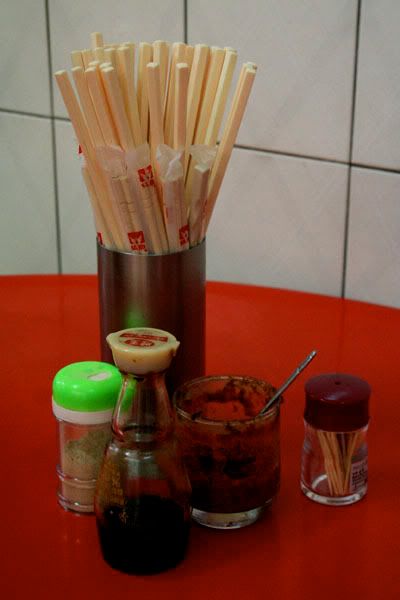 If you mention that you're visiting another town in Taiwan, you're more than likely to be told what kind of food you should eat when you get there. Despite its small size (or perhaps because of it), every town in Taiwan seems to have a local specialty, a 'famous food' that all visitors are obliged to try. Taiwan has a highly developed internal tourism infrastructure (unlike its international tourism infrastructure, which I'll discuss later), and one of the highlights for most Taiwanese travelers is sampling all the famous dishes of the island. People will pile into a car to try stinky green-bean curd, or board a bus to sample a rice lunch box. After a month and a half living in Hsinchu, Bordeaux and I decided to join these culinary travelers. We set out on a railroad trip around the entire island, and top of our itinerary was trying Taiwan's famous dishes.
If you mention that you're visiting another town in Taiwan, you're more than likely to be told what kind of food you should eat when you get there. Despite its small size (or perhaps because of it), every town in Taiwan seems to have a local specialty, a 'famous food' that all visitors are obliged to try. Taiwan has a highly developed internal tourism infrastructure (unlike its international tourism infrastructure, which I'll discuss later), and one of the highlights for most Taiwanese travelers is sampling all the famous dishes of the island. People will pile into a car to try stinky green-bean curd, or board a bus to sample a rice lunch box. After a month and a half living in Hsinchu, Bordeaux and I decided to join these culinary travelers. We set out on a railroad trip around the entire island, and top of our itinerary was trying Taiwan's famous dishes.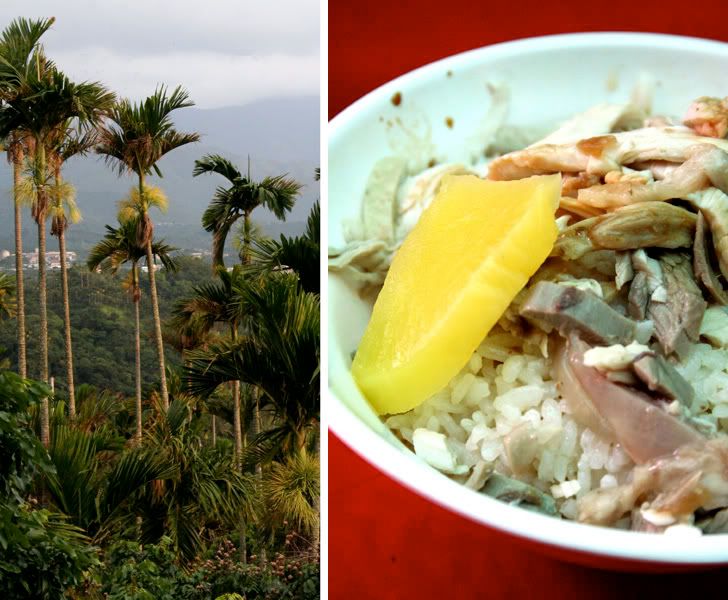 The town of Chaiyi sits at the line where Taiwan dips into the tropics. Yet it's special dish hardly evokes its torpid climate or lush landscape- turkey rice. It's nearly as simple as it sounds, strips of tender turkey eaten over a bed of white rice, and paired with a chunk of pickled turnip. It has a wholesome and hearty quality, reminiscent of a plate of Thanksgiving left-overs.
The town of Chaiyi sits at the line where Taiwan dips into the tropics. Yet it's special dish hardly evokes its torpid climate or lush landscape- turkey rice. It's nearly as simple as it sounds, strips of tender turkey eaten over a bed of white rice, and paired with a chunk of pickled turnip. It has a wholesome and hearty quality, reminiscent of a plate of Thanksgiving left-overs.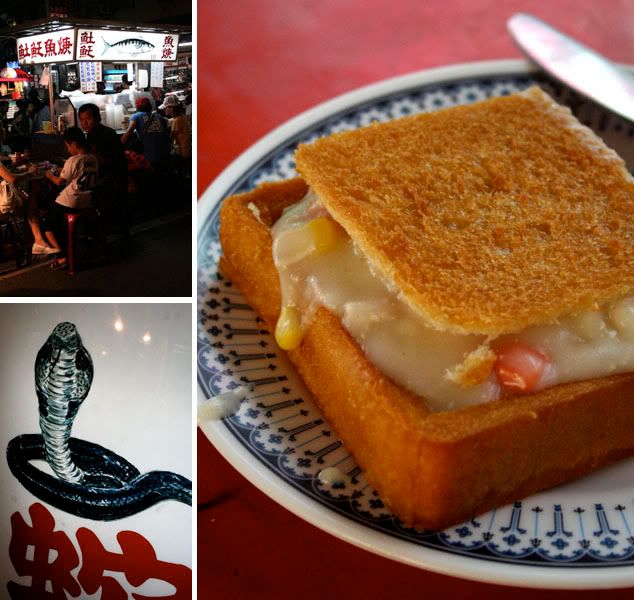 Our next stop was Kaoshuing, Taiwan's largest metropolis, and an attractive oceanfront city. After browsing in hip shopping streets, we headed over to the city's largest nightmarket. There we sampled a regional specialty, more associated with nearby Tainan than Kaoshiung. Named 'coffin bread' in English, it's a thick slice of texas toast fried, cut open, and filled with a creamy seafood chowder. Looking at it for the first time, I remarked to Bordeaux that it was the strangest food we'd eaten in Taiwan. He rightly pointed out that it's also the most American. It is in fact a remnant of American naval presence in southern Taiwan, and almost seems like a dish that could be served at an American seaside diner.
Our next stop was Kaoshuing, Taiwan's largest metropolis, and an attractive oceanfront city. After browsing in hip shopping streets, we headed over to the city's largest nightmarket. There we sampled a regional specialty, more associated with nearby Tainan than Kaoshiung. Named 'coffin bread' in English, it's a thick slice of texas toast fried, cut open, and filled with a creamy seafood chowder. Looking at it for the first time, I remarked to Bordeaux that it was the strangest food we'd eaten in Taiwan. He rightly pointed out that it's also the most American. It is in fact a remnant of American naval presence in southern Taiwan, and almost seems like a dish that could be served at an American seaside diner.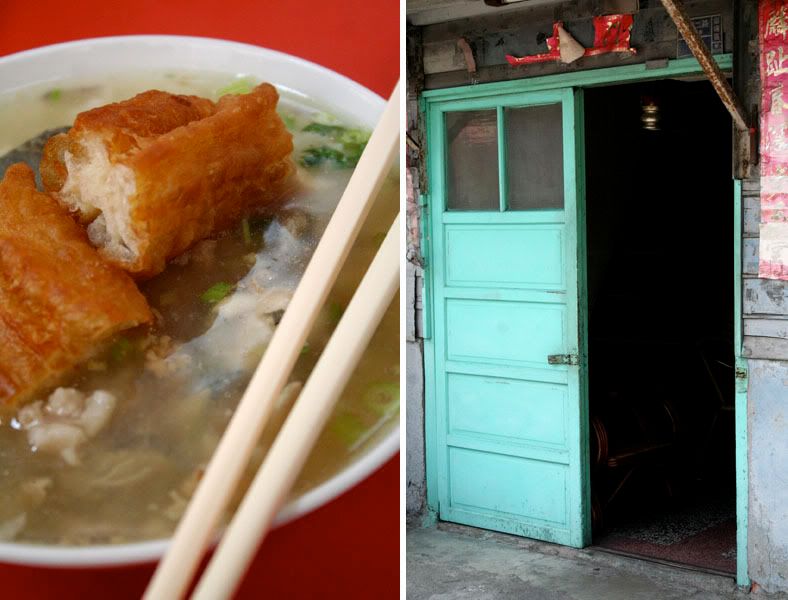 The next morning, we traveled across the Love River to the old area of town for another specialty, milk fish congee. It was a watery rice soup that contained not just milkfish, but also oysters, clams, and other fresh seafood. Eaten with chunks of long chinese donuts, it made a complexly nuanced breakfast- at times sweet and buttery, alternately fresh and salty.
The next morning, we traveled across the Love River to the old area of town for another specialty, milk fish congee. It was a watery rice soup that contained not just milkfish, but also oysters, clams, and other fresh seafood. Eaten with chunks of long chinese donuts, it made a complexly nuanced breakfast- at times sweet and buttery, alternately fresh and salty.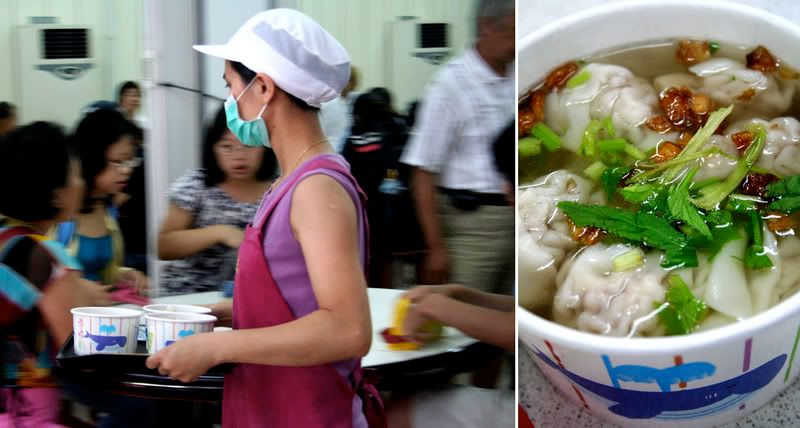 Arriving for lunch at a famed restaurant in Hualien, we for the first time found a line of diners. We briefly wondered if we should reconsider- but eventually gave in and joined the queue. The line moved quickly, and we were soon ushered to a shared table in a cavernous dining hall. The wait for our dish gave us time to consider- is being famous a good thing? Are we going to discover that this dish rests on its fame, nothing else? Then the paper dishes of bianshji were placed in front of us. The light broth was browned with charred garlic, almost giving it the flavor of Vietnamese pho. But it was set apart by the plump dumplings that floated in it- filled with an incredible mixture of ground pork and shrimp. Looking around the room, we saw that some tables had wisely ordered an extra bowl, so that each member of their party could savor one more dumpling.
Arriving for lunch at a famed restaurant in Hualien, we for the first time found a line of diners. We briefly wondered if we should reconsider- but eventually gave in and joined the queue. The line moved quickly, and we were soon ushered to a shared table in a cavernous dining hall. The wait for our dish gave us time to consider- is being famous a good thing? Are we going to discover that this dish rests on its fame, nothing else? Then the paper dishes of bianshji were placed in front of us. The light broth was browned with charred garlic, almost giving it the flavor of Vietnamese pho. But it was set apart by the plump dumplings that floated in it- filled with an incredible mixture of ground pork and shrimp. Looking around the room, we saw that some tables had wisely ordered an extra bowl, so that each member of their party could savor one more dumpling.Our trip definitely gave me some ideas to consider about travel. In a sense our mission to try Taiwan Famous ran counter to the traveler mandate to seek one's own path- yet at the same time, it was fun to insert ourselves into another culture's mode of tourism. And as we saw with these foods, sometimes a food is famous for a reason.